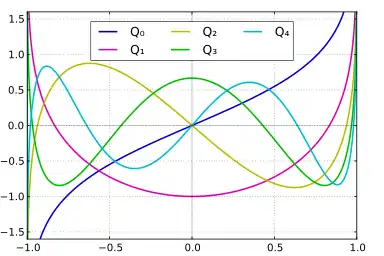Legendre function
In physical science and mathematics, the Legendre functions Pλ, Qλ and associated Legendre functions Pμ
λ, Qμ
λ, and Legendre functions of the second kind, Qn, are all solutions of Legendre's differential equation. The Legendre polynomials and the associated Legendre polynomials are also solutions of the differential equation in special cases, which, by virtue of being polynomials, have a large number of additional properties, mathematical structure, and applications. For these polynomial solutions, see the separate Wikipedia articles.

Legendre's differential equation
The general Legendre equation reads
where the numbers λ and μ may be complex, and are called the degree and order of the relevant function, respectively. The polynomial solutions when λ is an integer (denoted n), and μ = 0 are the Legendre polynomials Pn; and when
λ is an integer (denoted n), and μ = m is also an integer with |m| < n are the associated Legendre polynomials. All other cases of λ and μ can be discussed as one, and the solutions are written Pμ
λ, Qμ
λ. If μ = 0, the superscript is omitted, and one writes just Pλ, Qλ. However, the solution Qλ when λ is an integer is often discussed separately as Legendre's function of the second kind, and denoted Qn.
This is a second order linear equation with three regular singular points (at 1, −1, and ∞). Like all such equations, it can be converted into a hypergeometric differential equation by a change of variable, and its solutions can be expressed using hypergeometric functions.
Solutions of the differential equation
Since the differential equation is linear, homogeneous (the right hand side =zero) and of second order, it has two linearly independent solutions, which can both be expressed in terms of the hypergeometric function, . With being the gamma function, the first solution is
and the second is,
_with_n%253D0.5_in_the_complex_plane_from_-2-2i_to_2%252B2i_with_colors_created_with_Mathematica_13.1_function_ComplexPlot3D.svg.png.webp)
These are generally known as Legendre functions of the first and second kind of noninteger degree, with the additional qualifier 'associated' if μ is non-zero. A useful relation between the P and Q solutions is Whipple's formula.
Positive integer order
For positive integer the evaluation of above involves cancellation of singular terms. We can find the limit valid for as[1]
with the (rising) Pochhammer symbol.
Legendre functions of the second kind (Qn)

The nonpolynomial solution for the special case of integer degree , and , is often discussed separately. It is given by
This solution is necessarily singular when .
The Legendre functions of the second kind can also be defined recursively via Bonnet's recursion formula
Associated Legendre functions of the second kind
The nonpolynomial solution for the special case of integer degree , and is given by
Integral representations
The Legendre functions can be written as contour integrals. For example,
where the contour winds around the points 1 and z in the positive direction and does not wind around −1. For real x, we have
Legendre function as characters
The real integral representation of are very useful in the study of harmonic analysis on where is the double coset space of (see Zonal spherical function). Actually the Fourier transform on is given by
where
Singularities of Legendre functions of the first kind (Pλ) as a consequence of symmetry
Legendre functions Pλ of non-integer degree are unbounded at the interval [-1, 1] . In applications in physics, this often provides a selection criterion. Indeed, because Legendre functions Qλ of the second kind are always unbounded, in order to have a bounded solution of Legendre's equation at all, the degree must be integer valued: only for integer degree, Legendre functions of the first kind reduce to Legendre polynomials, which are bounded on [-1, 1] . It can be shown[2] that the singularity of the Legendre functions Pλ for non-integer degree is a consequence of the mirror symmetry of Legendre's equation. Thus there is a symmetry under the selection rule just mentioned.
See also
References
- Creasey, Peter E.; Lang, Annika (2018). "Fast generation of isotropic Gaussian random fields on the sphere". Monte Carlo Methods and Applications. 24 (1): 1–11. arXiv:1709.10314. Bibcode:2018MCMA...24....1C. doi:10.1515/mcma-2018-0001. S2CID 4657044.
- van der Toorn, Ramses (4 April 2022). "The Singularity of Legendre Functions of the First Kind as a Consequence of the Symmetry of Legendre's Equation". Symmetry. 14 (4): 741. Bibcode:2022Symm...14..741V. doi:10.3390/sym14040741. ISSN 2073-8994.
- Abramowitz, Milton; Stegun, Irene Ann, eds. (1983) [June 1964]. "Chapter 8". Handbook of Mathematical Functions with Formulas, Graphs, and Mathematical Tables. Applied Mathematics Series. Vol. 55 (Ninth reprint with additional corrections of tenth original printing with corrections (December 1972); first ed.). Washington D.C.; New York: United States Department of Commerce, National Bureau of Standards; Dover Publications. p. 332. ISBN 978-0-486-61272-0. LCCN 64-60036. MR 0167642. LCCN 65-12253.
- Courant, Richard; Hilbert, David (1953), Methods of Mathematical Physics, Volume 1, New York: Interscience Publisher, Inc.
- Dunster, T. M. (2010), "Legendre and Related Functions", in Olver, Frank W. J.; Lozier, Daniel M.; Boisvert, Ronald F.; Clark, Charles W. (eds.), NIST Handbook of Mathematical Functions, Cambridge University Press, ISBN 978-0-521-19225-5, MR 2723248.
- Ivanov, A.B. (2001) [1994], "Legendre function", Encyclopedia of Mathematics, EMS Press
- Snow, Chester (1952) [1942], Hypergeometric and Legendre functions with applications to integral equations of potential theory, National Bureau of Standards Applied Mathematics Series, No. 19, Washington, D.C.: U. S. Government Printing Office, hdl:2027/mdp.39015011416826, MR 0048145
- Whittaker, E. T.; Watson, G. N. (1963), A Course in Modern Analysis, Cambridge University Press, ISBN 978-0-521-58807-2
External links
- Legendre function P on the Wolfram functions site.
- Legendre function Q on the Wolfram functions site.
- Associated Legendre function P on the Wolfram functions site.
- Associated Legendre function Q on the Wolfram functions site.